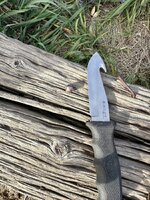Navigation
Install the app
How to install the app on iOS
Follow along with the video below to see how to install our site as a web app on your home screen.
Note: This feature may not be available in some browsers.
More options
Style variation
You are using an out of date browser. It may not display this or other websites correctly.
You should upgrade or use an alternative browser.
You should upgrade or use an alternative browser.
Why are bullets frequently found just under the hide on the opposite side?
- Thread starter cnelk
- Start date
BigNate
WKR
They don't have much surface area, so the small surface area yields higher pressure on that surface vs a well expanded mushroom spreading it over a larger area.It stretches... Never have recovered a Barnes TTSX like that though.
I've seen tiny exit wounds from the Barnes I have used. Don't use them much anymore.
I've shot nothing but Barnes TSX and TTSX for well over 20 years and I would say that half of my shots have ended up under the off side hide on elk and those have all been 150 yrds or less. The bullet expended all the energy inside the animal and hit the "trampoline" hide.
It has more to do with pressure and how a physical body is designed to stand up to pressure. If you blow up a balloon and slowly insert a long needle into it, you will find that the needle easily passes through the first side but is much more difficult to pass through the second side to exit the balloon due to the way forces are distributed.
Jay
Jay
180ls1
WKR
- Joined
- Apr 19, 2020
- Messages
- 1,907
Okay. I have thought about it.
Since it’s not complicated, How much does the hide have to stretch before the bullet breaks through?
I have a video of a 225eldm entering a hard quartering away buck. I was amazed how big the "temporary dent" was the bullet made as it pushed in. It by no means "cut" its way in.
I am going to take my force meter and do just that!!!Next animal you down, push a blunted arrow through the hide with a force meter and let us know.
I am interested.
Careful, the arrow may snap before it punctures.I am going to take my force meter and do just that!!!
I am interested.
The force meter I bought has some different screw on attachments I am going to use. Probably thread some stuff for it too.Careful, the arrow may snap before it punctures.
Making the contraption to hold the hide in a repeatable way is going to take the most time, I think. Gonna be simple, 2 wood frames and screw them together. But, make them in such a way that it completely traps the hide and doesn’t let anything slide. I think one larger than the other so they nest inside each other. So it is stretched like a drum.
- Joined
- Oct 22, 2014
- Messages
- 13,447
The force meter I bought has some different screw on attachments I am going to use. Probably thread some stuff for it too.
Making the contraption to hold the hide in a repeatable way is going to take the most time, I think. Gonna be simple, 2 wood frames and screw them together. But, make them in such a way that it completely traps the hide and doesn’t let anything slide. I think one larger than the other so they nest inside each other. So it is stretched like a drum.
That isn’t going to measure the force required on an animal.
No, it won’t, but still interesting and fun experiment.That isn’t going to measure the force required on an animal.
An entire hide on an animal will get a lot of stretch and the hide is connected by the fibers to the muscle and bone. And, a static force is going to be different than a moving bullet.
It will at least show the difference between a pointed object and a blunt one. I don’t even think I could push a mushroomed bullet through a hide. That will be an interesting comparison to me.
35WhelenAI
WKR
- Joined
- Nov 20, 2021
- Messages
- 2,149
Barnes bullets with copper petals cut tissue. They don't bludgeon it. Of course they will be more prone to exit cleanly and with a less impressive hole. At what point in the animals death did a small exit hole have a negative affect?They don't have much surface area, so the small surface area yields higher pressure on that surface vs a well expanded mushroom spreading it over a larger area.
I've seen tiny exit wounds from the Barnes I have used. Don't use them much anymore.
LostWapiti
WKR
I’m always conflicted on this. I love dumping energy but I also like having a big leaking hole.I have recovered a bunch of bullets under the far side hide. I think that's a good thing. All of its energy is absorbed into the animal. Mission accomplished I would say.
LostWapiti
WKR
5MilesBack
"DADDY"
It's not the effect on death, it's the effect on blood trails and being able to find the animals quickly and easily.At what point in the animals death did a small exit hole have a negative affect?
But even two holes doesn't guarantee that. I shot a cow one time with the 7mag and a 175gr Partition. Two holes, heart shot.......not a drop of blood in the snow for several yards and then only a single drop. Several yards later a few drops, then at about 100 yards a small pool, then at about 1/4 mile the cow slumped over a blowdown. Without snow she would have been tough to track.
Similar things happen with ML shots.......only one hole, and not a drop of blood on the ground.
35WhelenAI
WKR
- Joined
- Nov 20, 2021
- Messages
- 2,149
I get it, I'm playing a bit of the devils advocate here. No argumentative intentions intended. You found the animals, and didn't make mention a small exit was an issue with respect to finding the animals with the copper bullets.
You do mention the 175 grain Partition above. Yes, Partitions typically finish their path through an animal and exit with more or less bullet diameter frotal area after the front of the bullet has been lost during expansion.
You do mention the 175 grain Partition above. Yes, Partitions typically finish their path through an animal and exit with more or less bullet diameter frotal area after the front of the bullet has been lost during expansion.
roadrunner
WKR
The force meter I bought has some different screw on attachments I am going to use. Probably thread some stuff for it too.
Making the contraption to hold the hide in a repeatable way is going to take the most time, I think. Gonna be simple, 2 wood frames and screw them together. But, make them in such a way that it completely traps the hide and doesn’t let anything slide. I think one larger than the other so they nest inside each other. So it is stretched like a drum.
"Back in the day", the bowhunting crowd already did this with mechanical's and fixed. The mechanical tested to "debunk" lethality was the Punchcutter and the fixed with the lowest amount of "force" required to initiate a cut was the Bear Super Razorhead.
Yeah...it was that long ago.
omicron1792
WKR
- Joined
- Feb 20, 2024
- Messages
- 1,159
- Banned
- #40
Loo.wii
WKR
- Joined
- Sep 23, 2022
- Messages
- 790
Someone much smarter than me probably has a math equation that could answer this exactly.Okay. I have thought about it.
Since it’s not complicated, How much does the hide have to stretch before the bullet breaks through?
Similar threads
Featured Video
Latest Articles
- TT#64 Josh Boyd Elk Hunting Strategies for Every Season
- Aaron Davidson of Gunwerks
- TT#63 Dirk Durham’s Art of Elk Calling
- BIG Buck Stories with the Dirty Giants Podcast
- TT#62 Brian Barney Hunting Bulls without Calling
- Hoyt Alpha AX-2 SD Review
- Kuiu Kenai vs Outdoor Vitals Vario Hooded Jacket Review
- Hoyt RX-9 Ultra Review
- Hunting Vampire Bucks & Building an Optics Kit
- Darton Sequel ST2 35 Review


